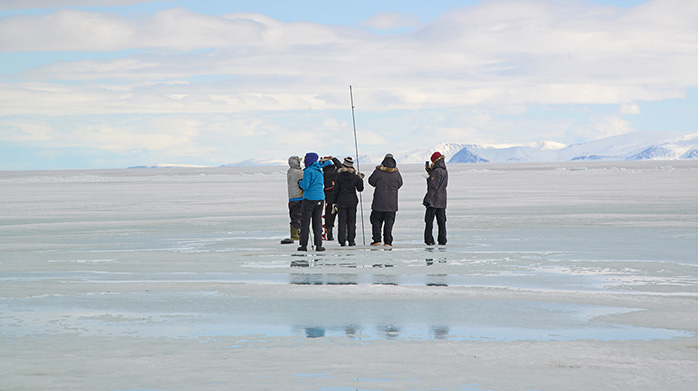Fieldwork of Ice and Fire

The team measures sea ice on the Arctic Ocean. Photo courtesy of Ben Edwards.
As summer heats up, students chill out with field research on arctic ice
by MaryAlice Bitts-Jackson
It was serene at the surface of the Arctic Ocean, with only the occasional seal ambling across the ice or wild bird flying above. But inside and under the ice, there were traces of a changing climate and a sea teeming with life.
Karuna Sah ’19, Ivy Gilbert ’18 and Billy Dougherty ’18 got a close-up view of that paradoxical world during a campout on sea ice at Canada’s Bay Island. Led by Professor of Earth Sciences Ben Edwards, the weeklong summer research trip was funded by longtime earth-sciences supporters John ’78 and Susan Wyckoff Pohl ’80, who took part in the excursion.
The students had performed preliminary independent research last spring, and once in Canada, they put what they’d learned in vivid context, observing bedrock geology, measuring sea-ice thickness and tracking pH and salinity in the water beneath the ice. They also seized the chance to drink in the region’s natural beauty and wildlife as they hiked, skied, kayaked and traveled across the ice in snowmobile-pulled komatiks.
“It was absolutely spectacular,” says Sah, an earth sciences major and physics minor who’s considering a career in glaciology, and who focused her research on valley glaciation and deposits. “During the 10 days we were there, the whole dynamic of the ice sheet we were on changed in front of our eyes.”
It also was a dream trip for Gilbert (English, earth sciences), who has been fascinated with the tundra since childhood. She researched the role global ocean currents and circulation play in ice formation, and she was blown away by the sounds she heard when she lowered an underwater microphone (hydrophone) under the ocean’s frozen surface.
“When you drop the hydrophone in, you hear the hustle and bustle of arctic life on full blast,” she says. “You can hear a bowhead whale, narwhal and seals all at once, all communicating.”
The trip was only one of the fieldwork excursions that earth sciences faculty members and students have taken this summer.
- Edwards also traveled to Iceland to study lava formed during volcanic eruptions, along with Michelle Orden ’17 (physics) and Will Kochtitzky ’16 (earth sciences).
- Alyson Thibodeau, assistant professor of earth sciences, investigated the geochemistry and archaeology of turquoise mining during a three-week trip to the American Southwest that included lab work in New Mexico with Zachary Keller-Coffey ’17 (earth sciences, political science).
- Marcus Key, Joseph Priestley Professor of Natural Philosophy, led a summer Mosaic on natural disasters along with Alex Bates, associate professor of Japanese language and literature, a course that took students to sites in Pennsylvania, New Jersey and Japan.
- Jessica Wolfman and Sophia Larson, both earth sciences majors in the class of '17, and Associate Professor of Earth Sciences Peter Sak conducted field work in Guadeloupe with support from a National Science Foundation grant. Obtained by Sak, the grant also will enable Assistant Professor of Earth Science Jorden Hayes to conduct a preliminary geophysics experiment there.
These international experiences open up new worlds of research and work for students, says Gilbert, who now knows that she wants to make travel and field work a priority. The only downside: dropping her phone and losing it—and all of her pictures—to the arctic sea. “The joke is that some lucky seal is going to send a wonderful Snapchat to everyone,” she says.
Learn more
- Department of Earth Sciences
- Research at Dickinson
- Active Learning
- “Next Level Research”
- Latest News
Published July 26, 2016